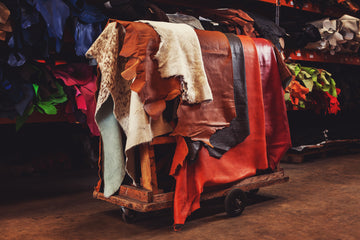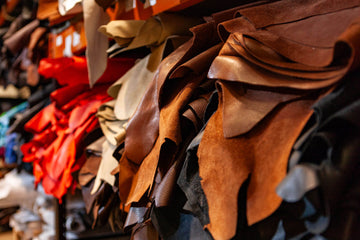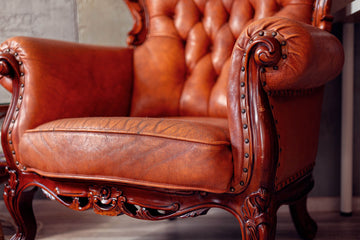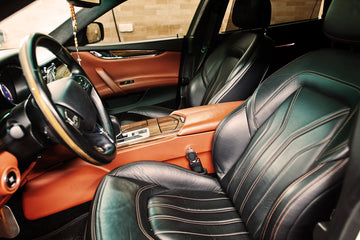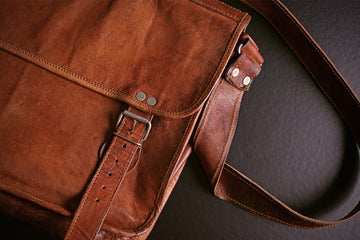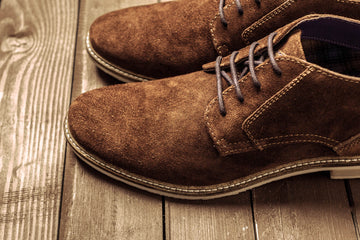Stepping into a leather goods store can be daunting with phrases such as "genuine leather," "top grain," and "full grain" plastered all over the price tags. That pricey faux leather jacket you've been wanting may not stand the test of time, and understanding these things could save you money while ensuring you make purchases that are durable, not a burden.
The leather sector employs misleading terms that take advantage of a shopper's lack of knowledge, potentially tricking even the most vigilant consumer into paying a premium value for substandard products. Marked prices of "genuine leather" are often intertwined with fancy marketing and misleading phrases, such as branding.
Hence, understanding the perplexing grading system would explain why there is such a stark difference between a 2-year lifespan knock-off faux leather purse and an authentic full-grain leather purse that ages wonderfully over decades.
This guide explains and breaks down intricate industry terms step by step, empowering you to differentiate between substandard and truly high-quality leather. No matter the purchase you want to make, whether it's furniture, clothing, or accessories, this guide will ensure you never have to worry about overspending and fuel your confidence, turning annoying surprises into pleasant ones.
What Are Leather Grades and Why Do They Matter
Leather grades indicate the quality of leather, its origin on the hide, and its potential uses. This explains why some leather goods are priced significantly higher than others, and why some items develop a stunning patina over time, while others simply crack and peel.
Your experience as a consumer is significantly influenced by several key factors that the grading process considers. The placement of the leather on the animal hide matters, since the back and shoulder sections are stronger and more fibrous than the belly and flank sections, which are frail and thin. Higher-grade leathers, such as full-grain leather, retain the surface of the hide and all its natural markings; lower grades are made by splitting the hide into several layers or, in some cases, bonding leather scraps with synthetic materials.
Knowing the grades helps identify marketing tricks used to amplify the value that's purely fabricated. The phrase "genuine leather" is quite popular, but it often indicates that the leather has been processed or reconstructed, and therefore of lower quality. On the contrary, "100% leather" or "Italian leather" does absolutely nothing in terms of logic grade without additionally stating fundamentals.
Considering the economically important factors, it is evident why only 10-15% of animal skins can be classified as full-grain leather. Full-grain leather's premium status ensures its price remains high; however, this tends to be beneficial in the long run, as the leather ages beautifully over time. On the other end of the spectrum, lower grades of leather might appear cheaper initially, but their rapidly degrading appearance means they often end up being more expensive over time.
The Complete Leather Grading System
Leather producers typically rank hides from best to worst in this order: Full Grain, Top Grain, Split Grain, and Bonded. Not every maker adheres to the same terms or hierarchy, and some brands utilise these names in ways that stretch the truth. Still, knowing the rough hierarchy keeps shoppers from paying top dollar for cheap imitations.
That ranking stems from how tanners work with each layer of a hide. When a skin first arrives at the tannery, it comes with layers stacked on top of one another. The top layer, the grain, maintains tight, long fibres and shows the tells and marks that make every piece one of a kind. Go a little deeper, and the threads bunch up, losing strength and the clean surface finish most buyers prefer.
Judging quality also means examining the scars, scratches, and other natural imperfections that appear on each hide. Many tanneries categorise their stock into standard, utility, and special grades based on the frequency of these marks, even if they leave the leather strong. Sometimes, a well-placed brand or a bug bite can add character and increase the price of the finished goods.
Learning how much of each hide grade is available helps make the cost more understandable. Full-grain leather is rare and pricey because it comes from just 10 to 15 per cent of a cow's skin. A larger portion ends up as top-grain, while the leftover bits that would otherwise be discarded are made into split and bonded grades. That leftover material still finds buyers, so the lower grades have a place in the market.
Full Grain Leather: The Premium Standard
Full-grain leather is widely regarded as the finest type of hide available; its name alone sparks comparisons with every other grade on the market. Because it comes straight from the outer layer of the skin, the material preserves the full grain, along with every little scuff, brand, and mark that tells a part of the animal's story.
Manufacturers leave the hide mostly alone, so its original strength and character stay in place. Unlike lower grades, full-grain leather skips buffing, sanding, or heavy dyes that might weaken the fibres or hide obvious flaws. That untouched face means customers always see the natural pattern while also enjoying the tight fibre web that makes full-grain leather so tough.
Perhaps the best part of full-grain leather is its ability to develop a beautiful patina over time. With regular use, skin oils, sunlight, and daily bumps slowly massage the surface into a deep, glowing finish. Rather than fading like many synthetic materials, the leather improves and becomes a one-of-a-kind conversation piece, much like a fine wine that develops layers over time.
Full-grain leather appears whenever people need a material that feels strong yet truly beautiful. Premium furniture makers choose it for couches and chairs expected to sit in homes for decades without giving in. High-end bag designers lean on full-grain because they want each piece to age gracefully and stay useful for a lifetime. Even boot brands that sell everything from work gear to polished dress shoes reach for full grain when they need something that keeps its shape and guards the foot season after season.
That added cost stems from the fact that perfect hides are rare, and the material simply withstands wear in a way that cheaper grades never will. A full-grain wallet may cost two or three times as much as a stamped genuine-leather piece, but it usually outlasts several of those alternatives. Over time, the surface develops subtle marks and a rich patina that synthetic skins can't reproduce, giving every item its own unique story. For many buyers, this long life and exceptional character make full-grain leather the smarter, more economical choice, even if the checkout price feels steep.
Top Grain Leather: The Refined Choice
Top grain leather sits just one notch below full grain on the quality ladder, offering shoppers a blend of high-end feel and a clean look that many appreciate. It starts with the same premium hide but receives a gentle sanding or buffing to smooth out small blemishes and reveal a smoother surface.
During this refining step, the very outer layer is carefully removed to eliminate scars, bug bites, and other marks that some buyers do not want to see. Once that is done, makers add dyes, pigments, and clear topcoats so that the colour and texture match evenly from edge to edge.
Some pieces sold as top grain are corrected-grain leather, which receives more intensive treatment. In that case, the surface is sanded even deeper, and fake grain patterns are pressed in, aiming to replicate the appearance of natural leather. It's still real leather, of course, but this extra treatment can compromise some of its strength and the unique character that makes leather so appealing.
Top-grain leather is typically chosen for projects where a consistent appearance is more important than maximum strength or the way natural scars and marks slowly tell a story over time. Designers often pick it for jackets, since its smooth, even surface takes dye easily and gives that sharp, modern vibe people want. Likewise, many mid-level furniture makers use top-grain when they need large sections to match a set colour without any surprising variations.
In terms of toughness, top grain falls between full-grain hides and lesser grades; it lasts well without the higher price tag that full-grain often commands. It may not develop the same rich patina as the full-grain option over time, but top-grain still holds up nicely, resists splitting, and usually looks better for a longer period than split or bonded leathers do.
Split Grain and Genuine Leather: Understanding the Lower Grades
Split grain leather is made from the lower layers of an animal hide, the section left over after the finer top grain has been shaved away. Because the dense, tightly packed fibres of the top layer are missing, split leather is far less sturdy and resilient than the premium grades.
The phrase' genuine leather' sounds reassuring, but in reality, it says more about marketing than quality. Most of the time, it simply describes split leather that has been coated with a synthetic finish to mimic the look of better hides.
These leather types come with a long list of drawbacks that buyers should be aware of. Because the fibre structure is open and loose, split and genuine hides stretch easily, tear if yanked hard, and soak up water at surprisingly low levels of humidity. The plastic top layer looks even, yet brittle, and soon develops cracks at edges, folds, and corners. Instead of creating a rich patina over decades, products made from this split material typically age poorly and appear worn out within just a few years.
In the U.S., the Federal Trade Commission requires that split leather be labelled as such; unfortunately, the rule isn't the same everywhere. Because of this, many foreign factories use terms such as "genuine leather" or "100 per cent leather" without specifying the grade, so buyers must still examine the details closely before making a purchase.
These lower-grade hides fill a market niche where price matters more than longevity. Split leather is used in budget furniture, book covers, and mass-produced keychains and wallets that mimic the look of leather at a lower cost. The items won't last as long as the top grades, yet with a bit of care and sensible use, they can usually hold up for several years.
Bonded Leather: The Budget Option
Bonded leather sits at the very bottom of the leather quality list and is made by mixing leftover scraps and dust with synthetic glues, so the sheet appears to be real hide. Depending on the batch, only about 10 to 25 per cent of what you see is actual leather; the rest is made from polyurethane, latex, or other artificial materials.
To make bonded leather, tannery off-cuts are gathered, ground to a fine powder, and combined with glue and a backing sheet. After the material is laid down, a synthetic top layer is usually added to give a final grain pattern and gloss.
Due to its high plastic content, bonded leather feels more similar to synthetic upholstery than to traditional leather furniture. That thick surface blocks the natural give, air flow, and heat control that real hides offer. Most people can easily spot bonded leather, thanks in part to its slick texture and the faint chemical smell that lingers for weeks.
Durability is by far the biggest weakness of bonded leather furniture and accessories. Because tiny leather scraps are mixed with synthetic glues instead of being stitched together, weak seams appear throughout the sheet. Most bonded leather pieces begin to show wear after just two to three years, with scratches and lines that crack, peel, or pull away from the paper-like backing. Because they fall apart so quickly, bonded leather is a poor buy, even though the sticker price appears friendly.
Many budget furniture makers cover sofas and chairs in bonded leather simply to fake the look of real hides at rock-bottom cost. Car companies add it to low-end models as a quick way to dress the cabin, and publishers pick it for cheap, tip-on book covers. Bonded leather meets those frugal markets just fine, but shoppers need to remember they are paying for a mostly synthetic product.
Speciality Leather Types and Finishes
Beyond the standard grading scale, several speciality leathers and finishes bring their look and feel to the table. Knowing how each one works makes it easier to choose the best option for what you plan to make and the style you want.
Nubuck starts life as high-quality full-grain hide, then artisans lightly buff or sand the outer layer until it feels soft and velvety. Because little depth is taken away, most of the strength and breathability of full grain stays intact. That gentle finish does mean Nubuck asks for extra care, though; its raised fibres soak up water and dirt more quickly than smooth leather.
Suede, by contrast, comes from the interior split side of the hide, giving it the distinctive fuzzy nap that many people love to touch. The trade-off is serious: suede simply isn't as tough as grain leather, since its fibre structure is looser and its surface more open. Because of this, moisture, mud, and even ordinary oils can damage a suede item, so owners should use the right brushes and protectors every time they clean.
Aniline leather derives its colour from soluble dyes that penetrate deeply into the hide, leaving no paint-like film on the surface. Because of this, the original texture breathes freely and the subtle grain pattern stays fully visible. Over time, the leather develops a rich patina, but the open-pore finish requires owners to shield it more carefully from spills and humidity.
Semi-aniline leather retains its dyed look while adding a thin, clear top coat that enhances overall toughness. This balanced approach makes the hide less prone to stains and everyday rubs, while keeping almost all the natural feel that fans love in pure aniline.
Pigmented leather, in contrast, is dressed in an opaque layer that completely hides the grain and instantly deadens colour scraping. Such a hard-wearing skin excels in hotels, cars and busy offices, but the trade-off is a loss of the soft touch and breathability that many seek in high-quality leather. Tanning Methods and Their Impact on Quality
Transforming raw animal hides into finished leather is known as tanning, and the chosen method will shape the final texture, durability, appearance, and even the eco-friendliness of the product. A brief overview of these processes helps explain why some leather items command a premium price tag, while others remain budget-friendly.
In vegetable tanning, plant-based tannins pulled from tree bark, leaves, and similar materials slowly work their way through the hide. Because the hides absorb the tannins a bit at a time, the traditional process spans two to three months and requires careful monitoring. The result is a firm, richly colored leather that ages spectacularly; the surface deepens in tone and character with every year of honest use.
Because it takes so long, vegetable tanned leather ends up with traits that many makers and shoppers actively seek. The stiff hand makes it perfect for structured goods like briefcases, belts, and saddles, items that need to hold their shape under daily pressure. That same firmness also lends itself well to tooling and stamping, so hobbyists and professional saddlers alike reach for it when their work requires decorative detail.
Chrome tanning utilises chromium salts to transform hides into leather in just one or two days, a speed that now makes the technique the standard in factories worldwide. Because of the quick turnaround, producers receive even, supple hides that take colour well and resist both moisture and moderate heat. While the method is economical on a large scale, it still demands careful storage, handling, and final disposal of the chromium-laden runoff.
Chrome-tanned leather is found in nearly every part of the modern marketplace, largely due to its balanced cost and performance. The relaxed yet durable feel suits jackets, pillows, and small goods such as wallets, where easy drape is more valued than rigid structure. As a result, most sofas, dress shoes, and everyday handbags owe their appearance and price point to this widely adopted tanning route.
Buyers who care about sustainability still weigh the trade-offs between tanning types. Vegetable tanning relies on renewable bark and leaf extracts, yielding biodegradable hides; however, the process can take months and requires significantly more water than chrome methods. Because chrome tanning speeds up the process, it reduces the time and energy needed per unit. However, the leftover sludge must be treated properly to prevent heavy metals from leaching into soil and rivers.
How to Identify Quality Leather
Knowing how to spot high-quality leather helps you avoid falling for clever ads and ensures your money buys something that truly lasts. You don't need fancy tools- your eyes, hands, and a few simple tests can tell you a lot about the hide in front of you.
Begin with the touch test, as it provides quick and honest feedback. Genuine top-grain or full-grain leather feels warm and soft in your hand, bending easily and springing back when pressed. Over the same area, the texture stays even, slowly changing shape to match your grip. Cheaper grades often feel cold and stiff like plastic, or fake-soft because a slick finish hides the real skin underneath.
The smell test is one of the easiest and most reliable ways to tell real leather from synthetic substitutes. Real leather emits a warm, earthy scent that many people find pleasant and distinctive. In contrast, faux leather or heavily processed bonded leather often has a sharp, almost chemical-like smell, especially when the piece is brand new. On hot days or when the material is bent, this plasticky aroma becomes even more noticeable.
Examining the edges and the way a product is assembled also reveals a great deal about its quality. Well-made leather goods have neatly cut edges that show the leather's natural fibres rather than raw or rough material underneath. Split leather typically reveals stacked layers along the edge, whereas bonded styles often display a distinct line where the top layer separates from the backing.
For an even closer look, a small magnifying lens can uncover details the eye misses. At just 10-power, the glass highlights the tight, random pores in full-grain leather versus the uniform pattern on embossed or synthetic surfaces.
Synthetic Leather Alternatives
Learning about synthetic leather options allows you to determine when artificial materials may better meet your needs than genuine leather. With each passing year, these options continue to improve in finish and eco-design, making them increasingly smart choices for certain roles.
Polyurethane, or PU leather, is the most widely used synthetic type; it is formed when a plastic layer is bonded to a fabric backing. Entry-level PU can look and feel very similar to real leather, so the difference often goes unnoticed by casual users. Premium grades, however, deliver an even finish, wipe-clean ease, and solid water resistance, which marketers tout as a key advantage for bags, furniture, and footwear.
Polyvinyl chloride, or PVC, stands apart because its chemistry and finish behave quite differently from those of PU. It usually costs less than PU, yet breathability, softness and stretch are poorer trade-offs. PVC shines in places where spills, rough handling, and fast clean-up count more than the luxury touch, so it appears in budget seats, briefcases and temporary covers.
Eco talk around synthetic hide is tricky because every route has downsides. Skipping animal farming eases some ethical pain, yet petrochemicals and heavy solvents still feed the process and pollute waterways. Suits last shorter than good cow leather, though, so products wind up in landfills sooner, a fact designers try to spin in greener shades.
Synthetic leather excels in settings where its unique traits offer distinct advantages over genuine hides. Boats and patio seating benefit from synthetic materials because they repel moisture and are easy to clean and maintain. Clinics and labs prefer the same product, since it can be wiped down and resists stubborn stains. Animal-conscious shoppers also opt for synthetics, eager to enjoy the look of leather without any animal-derived sources.
When it comes to pricing, synthetic and natural leather can differ significantly in terms of quality and the intended use of the item. Mid-range faux leather often costs thirty to fifty per cent less than its genuine counterpart, but its shorter lifespan can tip the budget balance back toward real hides. Entry-level synthetics carry a very low sticker price yet usually need replacing in one to five years, depending on how hard they are used.
Practical Applications by Leather Grade
Different grades of leather are designed for specific tasks, each offering a unique blend of strength, appearance, and price that suits a particular need. Knowing where each grade shines can guide you to the best option for your project and budget.
Full-grain leather leads the pack in settings where absolute toughness and a premium image are essential. Makers of luxury sofas and executive chairs often opt for full-grain leather because it ages beautifully and remains comfortable over decades of daily use. High-end luggage and handbag brands utilise the same materials, transforming their pieces into heirloom items that customers expect to carry for a lifetime. Boot makers leaning toward heavy-duty styles also opt for full grain, as it repels water, resists scuffs, and maintains the shape of shoes worn on job sites or trails.
Top-grain leather steps in when a cleaner, more uniform look is required, yet the item still needs to withstand everyday wear and tear. Fashion jackets often start from this hide, because its smooth surface takes colour evenly and works well with the latest dyes. Mid-priced seating also uses top grain, as small marks are less noticeable and routine cleaning is simpler than with full grain. Car companies looking to create a high-end interior often opt for top grain, ensuring the seat covers match exactly from panel to panel.
Split and genuine leather appear in projects where the classic look takes precedence over extreme wear and tear. Bookbinders opt for split leather because the cover looks good and won't deteriorate under heavy stress over the years. Belt makers use genuine leather for everyday waistbands that customers expect at a modest price and that hold up season after season.
The same grade helps budget furniture brands deliver a leather-like seat without pushing the listed price out of reach. Bonded leather steps in where shoppers need the very lowest cost, yet still want something that looks richer than plain plastic. Things mass-market sofas often wrap their arms and seats in bonded leather to hit a tight bottom line.
Entry-level car lines sometimes use it for door panels, trading a corner of prestige for savings on every unit. Even small items, such as phone pouches, can be made from bonded leather when makers want the touch of genuine hide but face strict budget constraints. Of course, thickness grades matter too, because a thin skin, whatever the grade, will show every crease and tear.
Jackets and workwear typically range from 1.0 to 1.4 mm in thickness, allowing for smooth seams while still enabling the wearer to move freely. Sofas and headboards, in contrast, require a thickness of 1.2 mm to well over 2.0 mm to ensure the surface remains stable under constant use. Influencing cost even more, the chosen finish and tanning process also add weight to the final hide by the time it reaches the factory floor.
Leather Care and Maintenance by Grade
Keeping leather looking great and lasting long starts with the right care, and what your piece needs depends on its quality and finish. By learning how each grade behaves, you can use the right products and steer clear of mistakes that ruin expensive items.
Full-grain leather ages beautifully but loses that charm if not conditioned regularly, so feed it every six to twelve months with a premium cream or balm. Watch for harsh sunlight and damp rooms, since both can dry the hide fast and promote cracking. Accept the slow colour change that patina brings; trying to stop it usually ends up looking worse than simply letting nature do its work.
Top-grain leather is more resilient to damage because its surface seal protects against stains, yet it still requires gentle cleaning and occasional conditioning. Wipe away spills quickly with a damp cloth and a little soap, then set a reminder to condition every six to eight months to keep the fibres flexible. Because the finish is even, most high-quality products will yield consistent results and maintain a uniform appearance.
Split and genuine leathers still require a little extra attention because a factory coating covers their surfaces. Try not to soak them with water or conditioner, since the layer can lift or peel if pushed too hard. Stick to cleaners specifically designed for treated leather and always test any new product in a hidden area before applying it to visible surfaces. Over the months and years, you may notice the colour deepening or the finish dulling as the coating slowly wears away.
Bonded leather is the most fragile type, so it requires very gentle use from the start. Wipe it with a damp cloth, using only light pressure, to avoid pulling the top layer away from the paper and plastic backing. Standard leather conditioner is a poor fit here because it can form bubbles or cause the surface to shrink. Plan for nicks and scratches, then accept that when they add up, replacement is better than trying to fix what can't be fixed.
Leather with speciality finishes requires its playbook, as the usual routine might compromise the look. Nubuck requires a soft suede brush to be passed over regularly to keep the raised nap even and lift away crumbs. Suede itself loves a protective spray mist and demands quick action on spills, as water stains can be permanent. Aniline leather drinks in every spill, so wipe it up quickly and treat the skin with conditioner every few months to prevent dryness and cracking.
Making Smart Leather Purchases
With a solid grasp of leather grades and traits, you can shop for leather goods with confidence and steer clear of the traps that catch many first-timers. Buying strategically lets you spend wisely and end up with pieces that fit your needs and that you'll be proud of for years.
Whenever possible, handle leather items in person, as online pictures often fail to capture the subtle feel that distinguishes good leather from the rest. Run your hand over the surface to check for softness and bend it gently to see how it moves. Look for an even grain and the occasional scar or mark that shows its true full-grain nature.
Take time to read the product details and don't hesitate to ask targeted questions about grade, tanning process, and how the piece was stitched. A reliable seller will clearly explain the origin of their leather and describe the processing method used to produce it. Be cautious of broad claims, such as 'genuine leather' or '100% leather,' that lack specific grade labels. Before making a significant purchase, confirm the warranty's length and the ease of returning the item if it doesn't meet your expectations.
Match the price you see with the quality you expect to spot true value and steer clear of items that are either overpriced or advertised as unbelievable bargains. Full-grain leather typically costs more because it ages well, becomes softer over time, and rarely requires early replacement. So when a so-called full-grain piece is priced far below the market norm, take a close look-it may be corrected-grain or split leather hidden behind a tempting label.
Look for brands with a long track record of honest labelling and consistently high quality. Some makers focus on full-grain, others on corrected, so matching their speciality to your project can save time and money. Customer reviews matter, but pay special attention to comments about how the leather ages and holds up after years of normal use.
Always consider the true cost of ownership, including the expense of treating, repairing, or even replacing a piece when it finally fails. Premium leather may need pricier conditioner, yet its rare need for replacement usually offsets that extra expense. Additionally, consider the planet: cleaner tanning methods and longer-lasting products ultimately reduce waste and pollution.
Cultivating ties with knowledgeable local shops pays off every time you need guidance, care tips, or an unexpected repair. Stores that handle quality leather often provide in-house stitching, spare parts, and frank advice on what to buy and what to skip. Those enduring relationships turn into go-to resources that keep your gear in top shape and help you shop smart down the road.
When you learn the basics of grades, markings, and upkeep, confusion gives way to confidence you can feel at any counter. That practical know-how leads to purchases that deliver value, saving money and disappointment long after the checkout line.
Think of quality leather like a good bottle of wine-it gets better instead of worse the longer you own it. Yes, top-grade hides require a larger upfront investment. Still, that extra money pays off as they resist daily wear, develop a rich patina, and last far longer than the supermarket variety. Buy one well-made item instead of a handful of budget knock-offs, and you'll see for yourself how leather can soften, gain stories, and look genuinely handsome with every passing year.
